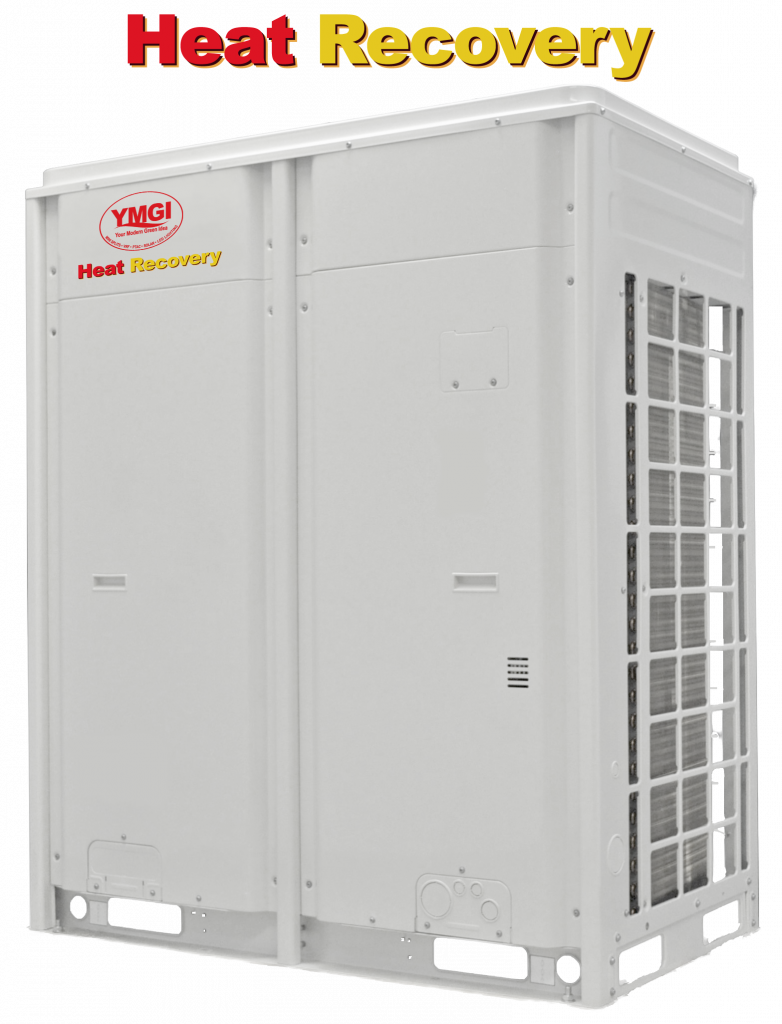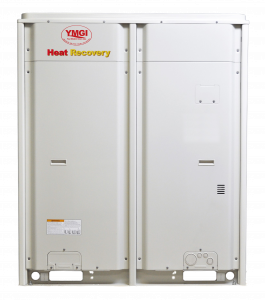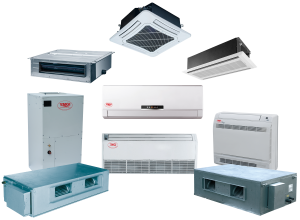
YMGI VRF Heat Recovery Series Modular
A VRF SYSTEM THAT IS EFFICIENT AND FLEXIBLE. Simultaneous Heating and Coolong.
YMGI’s Heat Recovery VRF systems are designed to deliver comfort year round. With YMGI’s Heat Recovery VRF System, you can use the same system to simultaneously heat and cool multiple rooms. Replace traditionally designed gas furnace and AC/HP coil & outdoor unit systems. YMGI Heat Recovery VRF systems save money on installation and operation.
What is Variable Refrigerant Flow?

Variable Refrigerant Flow, or VRF technology, is a heating and cooling system that routes 2 or 3-pipe refrigerant circuits from one outdoor unit to multiple indoor units (or zones) and can provide heating and cooling at the same time as different zones require. A Heat pump only VRF system (2 pipe circuit) supply heating or cooling multiple zones but they can’t heat and cool at the same time. A Heat Recovery VRF system (3 pipe circuit) can supply heating and cooling to multiple zones at the same time.
Traditional refrigerant systems are either “on” and operating at 100% capacity or “off”. VRF systems utilizes inverter compressor technology, which provide variable speed operation. Why is this so important? Because your HVAC systems seldom needs to provide 100% of the capacity they are designed for. Operating at such extremes can and often do lead to premature component or system failure.
VRF systems routinely operate at partial loads in the range of 30 to 70% which provides more consistent indoor temperatures and humidity levels while offering energy efficiency.
Because of this partial-load capability, VRF systems are often more efficient, than commercial chiller/boiler systems while at the same time offering much greater design flexibility while using much less installation space.
Contractor Selection is Very Important
To get the efficiency, durability, and superior control these systems are designed for, the piping and control systems must be installed according to the manufacturers’ very precise instructions. VRF systems are complex, and to ensure proper operation and longevity, all installations must be performed by licensed HVAC professional trained in VRF system installation.
Start-up and commissioning should be performed only by a manufacturer certified commissioning agent which may be a qualified contractor, manufacturer’s representative, or manufacturer’s employee. VRF manufacturers limit and void their warranties on systems not properly installed and commissioned.
YMGI VRF Advantages

- Efficiency: VRF systems are better than chillers and much more efficient than standard splits and RTU’s.
- Because of it’s smaller footprint, VRF Systems can be installed in a smaller area, so equipment takes up less square footage.
- Individual room control: indoor units can heat and cool independently.
- Durability: VRF Systems are designed to withstand harsh environments and operate for years. These systems have also been outlasting chillers.
- Excellent dehumidification: which is great for building preservation.
- Design flexibility: wall mounted, ceiling mounted, concealed non-ducted cassettes fit in frames for acoustical ceiling tiles, and concealed ducted indoor units.
- Very low maintenance (particularly when compared to central systems).
- Modular installation: these systems are great for retrofits, adding additional tonnage, and phased construction.
- No gas required; all electric. No auxiliary heat strips needed.
- Suitable for a broad geographical range. These systems perform to subzero temperatures(-22°F).
More Installation Options
HEAT RECOVERY VRF systems offer a variety of Indoor Unit options. If you’re doing a retrofit, the HEAT RECOVERY VRF can use our ducted Indoor Units and bolt onto existing duct work. For new construction, we offer 4 different Indoor Units that allow you to go ductless, giving building occupants the flexibility to control their comfort at whatever level they would like in the room they are occupying.
Benefits
Energy efficiency.
VRF systems are designed to provide exactly the amount of cooling needed for the current conditions, which means it runs less frequently and at a lower capacity. The VRF system is also designed to capture heat from the cooling process and reuse it in other areas that may need heating.
Quiet operation.
In a VRF system, the noisier condensing unit is typically outside, and the indoor air handlers are smaller and quieter than a traditional split system.
Heat and Cool simultaneously.
The VRF system captures residual heat absorbed from the air during the cooling process, and redirects that heat to other parts of the building that need heat. That means you can have air conditioning in the living room for a party, while you heat the bedroom where the baby is sleeping. Or you can have heat in the winter for cooler window offices, and air conditioning in the central conference room for a large meeting.
Consistent comfort.
The VRF system’s compressor can detect the precise requirements of each zone, and send the exact amount of refrigerant needed to do the job. As a result, each area of your space is consistently comfortable with well-controlled humidity and no hot or cold spots.
Less Downtime.
Since the VRF system is designed to run only when needed and under partial-load conditions, there is less wear and tear on the parts. That means fewer breakdowns. Also, if something goes wrong with one air handler, often the others are unaffected. That means your whole space won’t be without air conditioning all at once.
Requires Less Installation space.
Since the air handlers are smaller and VRF systems don’t usually require ducts, they don’t require as much wall and ceiling space for the equipment. That means you get to keep those gorgeous high ceilings in your apartment.
Modern Controls.
For residences, you can take advantage of mobile control technology that lets you adjust temperature settings for each zone from your mobile device. For commercial settings, the VRF system’s built-in controls may allow you to skip purchasing expensive building management software.
Let’s not forget maintenance
Like other HVAC systems, VRF systems do need to be regularly inspected and maintained by a professional. With such a sophisticated system, you want to be sure to choose a provider with the right experience, and who can design a maintenance contract based on the needs of your system.
| Model | Unit | VRFO-72VR-V3C(55)5 | VRFO-96VR-V3C(55)5 | VRFO-120VR-V3C(55)5 |
| Capacity Range | Ton | 6 | 8 | 10 |
| Cooling Capacity | kBtu/h | 72,000 | 96,000 | 120,000 |
| Heating Capacity | kBtu/h | 81,000 | 108,000 | 135,000 |
| Air flow volume | CFM | 8240 | 8240 | 8240 |
| Power Supply | V/Ø/Hz | 208~230/3/60 | 208~230/3/60 | 208~230/3/60 |
| MCA | A | 35 | 39 | 74 |
| MOP | A | 50 | 60 | 100 |
| Maximum No. if Connected IDU | – | 12 | 16 | 20 |
| Refrigerant Charge Volume | lbs. | 21.2 | 24.7 | 26.0 |
| Sound Pressure Level | dB(A) | 61 | 61 | 63 |
| Liquid Pipe | In. | Ø 3/8 | Ø 3/8 | Ø 1/2 |
| Gas Pipe Low Pressure | In. | Ø 3/4 | Ø 7/8 | Ø 1 1/8 |
| Gas Pipe High Pressure | In. | Ø 5/8 | Ø 3/4 | Ø 7/8 |
| Unit Dimensions (WxHxD) | In. | 52 3/4 x 30 1/8 x 63 1/5 | 52 3/4 x 30 1/8 x 63 1/5 | 52 3/4 x 30 1/8 x 63 1/5 |
| In. | 56 x 33 x 69 7/8 | 56 x 33 x 69 7/8 | 56 x 33 x 69 7/8 | |
| Net Unit Weight | lbs | 683 | 683 | 794 |
| Net Shipping Weight | lbs. | 716 | 716 | 827 |
| Base Pan Heater | – | YES | YES | YES |

